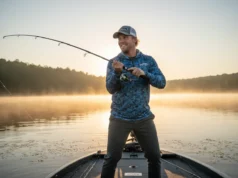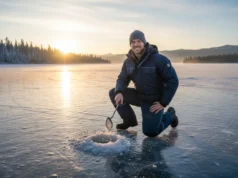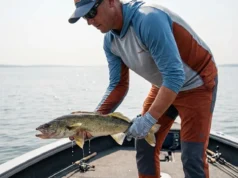In this article
The air is thick with the smell of wet earth and ozone as the last of a storm rumbles into the distance, leaving a falling barometer in its wake. This change in atmospheric pressure is a signal. Below you, the familiar, gentle river has transformed into a surging, chocolate-brown force. For many, this is a sign to pack up and head home. But for the prepared angler, this system-wide reset is a dinner bell that signals increased fish activity. This guide provides the blueprint to decode the chaos, turning the science of a river in flux into a precise, actionable strategy for consistent success. A rain-swollen river isn’t an obstacle but a puzzle; understanding its new rules and how rain affects fish behavior transforms a challenging environment into a highly predictable and rewarding angling opportunity.
We’ll deconstruct the science of this transformation, from the critical changes in flow and water chemistry to the predictable ways fish respond to them. We will build tactical, species-specific blueprints for bass, trout, and even channel catfish, and move beyond guesswork with a unique, data-driven timeline that identifies the peak “prime fishing window” for post-rain conditions. By the end, you’ll feel empowered with a framework to confidently read the water, ensure your safety, and strategically target the peak of post-rain activity.
Understanding the Transformed Environment: The Science of a River in Flux
To build an effective strategy, we must first understand the profound environmental changes a river undergoes after a heavy rain. This isn’t just more water; it’s a complete reset of the ecosystem, driven by powerful hydrological and chemical forces that trigger an aggressive fish bite.
How does rain physically alter a river’s flow and level?
A rainfall event’s impact begins the moment a drop hits the ground. In a healthy watershed, much of this water infiltrates the soil, but a big rain alters the equation. Surface run-off occurs when water flows overland, a process that drastically raises water levels and flushes food—like worms and crawling critters—directly into the river. Urbanized areas with impermeable surfaces act like massive funnels, accelerating this pulse of water and nutrients into runoff areas.
This surge dramatically increases two key hydrological parameters: discharge, the volume of water (measured in cfs), and velocity, the speed of the water. Together, these factors create current and cause a rapid rise in water level, known as gage height, leading to a river being “in spate”—a condition of high, fast-flowing water that demands respect. This increase in river flow is a critical change.
Fortunately, we can monitor these changes in real-time. Tools like the USGS National Water Dashboard provide a constant stream of data, which USGS explains rain and precipitation effects in great detail. This data is displayed on a hydrograph, a simple graph showing the river’s discharge. By analyzing its curve, an angler can determine if a river is experiencing rising or falling water levels. A rising hydrograph signals danger. A cresting or steadily falling hydrograph signals safer fishing conditions. This data-driven approach builds on the fundamentals of reading a river, connecting visual cues to hard science.
How does runoff change the river’s water chemistry and quality?
But this surge isn’t just water; it’s a slurry that fundamentally changes the river’s chemistry. The most obvious change is turbidity, creating muddy water as runoff carries sediment and debris. This high turbidity and reduced visibility forces visual predators like bass and trout to rely on other senses.
Initially, the turbulence and aeration from the surface water increases oxygen levels, an oxygen boost that can energize fish and stimulate activity. However, a secondary effect often follows as organic matter decomposes, a process that consumes dissolved oxygen and can create “dead zones.” You can explore the EPA’s analysis of dissolved oxygen to understand this critical process. Water temperature is also affected; a summer steady rain cools water temperature and can trigger feeding, while a cold spring rain can cause a sharp drop, shutting down the bite. Finally, watershed health is critical. Runoff from a forest introduces food, while runoff from agricultural areas can introduce pollutants but also a nutrient boom that species like Channel catfish and chubs exploit in the muddy currents.
How Fish Respond: A Primer on Post-Rain Behavior
This is where environmental science translates into the language of fish behavior. By understanding how active fish react to these new, challenging conditions, we can predict exactly where they will go and how they will hunt.
Where do fish relocate in high and fast water?
Energy conservation is the primary driver of relocation. Holding in the main channel is unsustainable, so fish actively seek out current breaks—any feature that creates pockets of calmer water.
The most common current break is an eddy, a pocket of slack water behind an obstruction like a boulder or logjam. Fish will stack up in these eddies to rest and ambush prey. The seam—the border between fast and slow water—is a conveyor belt for food. Fish will hold on the edges of clear and muddy water, darting out for easy meals before returning to points downstream. Other refuges include the inside bends of a river. This behavior concentrates the majority of a river’s fish—from largemouth and smallmouth bass to walleyes and trout—into small, predictable areas. This is a core principle explained by NOAA Fisheries’ definition of river habitat, and it aligns with the biological instincts of largemouth bass who relate tightly to structure.
Once fish have found these refuges, they face their next challenge: hunting in a visual blackout.
How do fish hunt when they can’t see?
In turbid water, visual predators adapt. The lateral line becomes the primary hunting tool, a sensory system that detects movement and vibration. A fish can “feel” a lure long before it sees it, which is why brighter, noisier baits and larger spinners that create a strong “thump” are so effective in dark conditions.
Smell and taste (chemoreception) also become critical. A hard rain flushes food into the river, from small aquatic creatures to fresh baits like worms and clams, creating a scent trail that species like Channel catfish can follow. This mobile buffet triggers an aggressive feeding frenzy, as confirmed by research on turbidity-induced changes in feeding. Simultaneously, the murky surface reduces the threat from overhead predators, as the associated thunder and lightning often spooks fish into cover, making them less wary once the storm passes. While these principles are universal, applying them effectively means choosing the best lures for largemouth bass and other species requires a tactical approach.
Pro-Level Tactical Blueprints: Species-Specific Strategies
Now we take the science and behavior and forge it into actionable game plans. Bass, trout, and other species react differently to post-rain conditions, and our tactical adaptations must reflect that.
What is the post-rain game plan for targeting bass?
For die-hard fishermen, bass fishing post-rain is a prime opportunity. The most important location is the “mudline”—the edge where muddy water meets clear water. Bass patrol this zone, using the murky water as cover to ambush prey. Focus your efforts on inflow points like the mouths of feeder creeks and drainage areas, as these spots funnel food.
Pro-Tip: When fishing an inflow point, don’t cast directly into the turbulent water. Cast your lure several feet past the current, into the calmer water, and retrieve it back through the seam. This presents the lure naturally, as if it’s being swept into the feeding zone, and is far more likely to trigger a reaction strike.
Your lure selection should prioritize maximum vibration and water displacement. Use brighter baits and larger lures in the murk—think spinnerbaits with double Colorado blades, vibrating jigs (Chatterbaits), and wide-wobbling square bill crankbaits. For colors, you want a strong silhouette or high contrast colors. Dark, natural colors like black and blue are visible, while bright fluorescents like chartreuse offer high contrast. Presentations must be tight to cover. If a cold rain has dropped the water temperature, a slow presentation is key.
How should you adapt your strategy for post-rain trout?
While bass adapt, sensitive species like trout—including brown trout, brook trout, and rainbow trout—react with a strategy of refuge. This approach is especially effective during the spring bass fishing season, when rain is common.
Trout abandon the main channel for the river’s absolute margins. Look for them tight to the bank and along the banks in shallow water where friction slows the current. They will stack up in any available slack water. One of the most reliable fly fishing strategies is to move upstream into smaller, clearer tributaries, as big trout will actively migrate out of a blown-out river.
Pro-Tip: Don’t overlook the smallest pockets of soft water. A patch of calm water the size of a dinner plate behind a rock is often big enough to hold a large, resting trout. A precise, drag-free drift through that tiny window is often the key to success.
Your presentation must be deep and slow. Employ weighted flies, streamers, and buggers—like a dark wooly bugger or a Shenks Sculpin—that create a distinct profile. Use heavily weighted flies and tungsten bead heads to get to the bottom. High-stick nymphing is ideal. Crucially, use a heavier tippet than normal (e.g., 3X or 4X) to control strong fish. This strategy aligns with our guide to the best lures for trout fishing, emphasizing profile and depth.
These same principles apply to other river species. Walleyes will move to the edges of current breaks, often requiring larger, deeper lures to reach them. Pike and Panfish will also push into newly flooded shoreline vegetation, ambushing small prey items washed in by the runoff.
The Angler’s Post-Rain Safety Protocol
A swollen river in spate conditions is a powerful force. Your safety is non-negotiable and begins with understanding the specific safety risks before you plan your fishing trip.
What are the most critical dangers to identify on a swollen river?
The most insidious danger is Flash Floods. A storm miles upstream can send a surge downstream with no warning. Be vigilant for signs like a sudden rise in water level or change in color, and evacuate to high ground immediately. Don’t forget the risk of lightning and thunder during a storm, or mudslides along saturated banks after one.
Unstable Banks and Erosion are common. Stay on established trails and away from the edge. The water also hides Unseen Submerged Hazards like logs and drop-offs. Finally, stormwater carries waterborne pathogens. As The National Park Service guide to river safety points out, awareness is your first line of defense. Always check the upstream forecast and file a “Float Plan” with someone. Recognizing these dangers is the first step; the next is equipping yourself with the right gear, like how high-quality fly fishing waders can provide protection, and techniques.
What gear and techniques are essential for wading safely?
Having the proper gear is a lifeline. A wading staff is your single most important tool. A snug-fitting wading belt is critical. Traction footwear, like boots with metal studs, is essential. A Personal Flotation Device (PFD) is not optional in high and cold water, a recommendation from Washington State guidance on water safety.
When crossing a current, always angle diagonally upstream. If you fall, do NOT try to stand up. Flip onto your stomach and swim aggressively toward the nearest shore. Once there, crawl completely out before standing. With a firm grasp on safety, we can now build our timeline.
The Post-Rain Angling Timeline: An Information Gain Opportunity
A river’s recovery is a gradual process. By breaking it down into phases, we can move from danger to the heart of the prime fishing window.
How long does it actually take for a river to recover?
A 2024 study on river resilience found the median recovery time for river productivity after a flood was 7.3 days. However, this is just a median. The actual time varies dramatically. Key factors include stream size (smaller streams can clear in 2-10 hours, while large rivers take days) and the presence of upstream dams or floodgates. The rain’s intensity and the watershed’s health are also critical, as noted in the University of Nevada, Reno research on river resilience. This data highlights the need for a dynamic approach.
What is an actionable, phased timeline for fishing after a storm?
By integrating science with live data, we can build an actionable timeline.
- RED ZONE (0-3 Hours Post-Storm): The river is rapidly rising and extremely muddy. This is the EXTREME DANGER phase with the highest risk of flash floods. Do NOT fish or wade. Use this time to monitor USGS data.
- YELLOW ZONE (3-12 Hours Post-Storm): The river is cresting or just beginning to fall. Water is heavily stained. Wading is extremely dangerous and should be avoided. Fishing in the rain or just after, fish only from high, stable banks, targeting key inflow points.
- GREEN ZONE (12–48 Hours Post-Storm): The river is on a steady, predictable fall, and water clarity improves to “stained.” This is the PRIME FISHING WINDOW. Fish are actively feeding in predictable locations. Wading may be possible with extreme care. During this zone, target bass on mudlines, trout on soft inside edges, and catfish in current breaks.
- NORMALIZATION (48+ Hours): The water level is approaching its pre-storm baseline. Conditions are stabilizing, and fish begin to disperse. It’s time to transition back to standard tactics.
This phased approach empowers you to move from guessing to a proactive strategy. When you hit that prime window, remember to practice proper catch-and-release techniques to ensure the fishery’s long-term health.
Conclusion
A rain event is a catalyst. It reshapes a river’s hydrology and chemistry, creating a unique angling opportunity where active fish become more aggressive. Fish respond predictably, relocating to current breaks and switching their hunting senses from sight to vibration and smell. Success requires a non-negotiable, safety-first protocol. By leveraging real-time data and a phased timeline (Red, Yellow, Green Zone), any angler can proactively target the peak of the post-rain bite, transforming chaos into a readable system.
Use these principles on your next post-rain outing and share your experience—or your own local river insights—in the comments below.
Frequently Asked Questions about River Fishing After Rain
Is it good to fish in a river right after it rains?
It is generally best to wait a few hours after a heavy rain. The initial period (0-3 hours) carries the highest risk of flash floods, while the “prime” fishing window typically opens 12-48 hours later as the water level begins a steady fall.
Is it better to fish before or after rain?
Both periods are excellent. The period just before rain is marked by a falling barometer and low pressure fronts, which often triggers an aggressive feeding frenzy. The period after rain concentrates fish into predictable locations and provides a sustained feeding window as the river stabilizes.
What color lure is best for muddy river water?
Dark or bright fluorescent colors are best for cloudy water. Dark colors like black and blue create a strong silhouette that is easier for fish to see. Bright colors like chartreuse offer high contrast colors and are excellent choices for noisier baits in the murk.
Do fish bite when the river is rising?
Yes, the fish bite can be aggressive as a river is rising, but it is also the most dangerous time for an angler. As water levels rise, fish move into newly flooded drainage areas to feed. Due to the extreme danger of rising currents and flash floods, it is safest to target these fish from high, stable banks and avoid wading entirely.
Risk Disclaimer: Fishing, boating, and all related outdoor activities involve inherent risks that can lead to injury. The information provided on Master Fishing Mag is for educational and informational purposes only. While we strive for accuracy, the information, techniques, and advice on gear and safety are not a substitute for your own best judgment, local knowledge, and adherence to official regulations. Fishing regulations, including seasons, size limits, and species restrictions, change frequently and vary by location. Always consult the latest official regulations from your local fish and wildlife agency before heading out. Proper handling of hooks, knives, and other sharp equipment is essential for safety. Furthermore, be aware of local fish consumption advisories. By using this website, you agree that you are solely responsible for your own safety and for complying with all applicable laws. Any reliance you place on our content is strictly at your own risk. Master Fishing Mag and its authors will not be held liable for any injury, damage, or loss sustained in connection with the use of the information herein.
Affiliate Disclosure: We are a participant in the Amazon Services LLC Associates Program, an affiliate advertising program designed to provide a means for us to earn advertising fees by advertising and linking to Amazon.com. As an Amazon Associate, we earn from qualifying purchases. We also participate in other affiliate programs and may receive a commission on products purchased through our links, at no extra cost to you. Additional terms are found in the terms of service.





